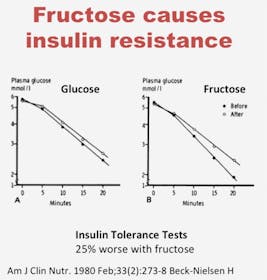Fructose and fatty liver – why sugar is a toxin

Fructose is even more strongly linked to obesity and diabetes than glucose. From a nutritional standpoint, neither fructose nor glucose contains essential nutrients. As a sweetener, both are similar. Yet fructose is particularly malevolent to human health compared to glucose due to its unique metabolism within the body.
Glucose and fructose metabolism differ in many significant ways. Whereas almost every cell in the body can use glucose for energy, no cell has the ability to use fructose. Once inside the body, only the liver can metabolize fructose. Where glucose can be dispersed throughout the body for use as energy, fructose is targeted like a guided missile to the liver.
When large quantities of glucose are eaten, it circulates to virtually every cell in the body, helping disperse this load. Body tissue other than the liver metabolizes eighty percent of ingested glucose. Every cell in the body, including the heart, lungs, muscles, brain, and kidneys help themselves to this all-you-can-eat glucose buffet. This only leaves the remaining twenty percent of the incoming glucose load for the liver to mop up. 


The same does not hold true for fructose. Large quantities of ingested fructose goes straight to the liver, since no other cells can help utilize or metabolize it, putting significant pressure on the liver. Levels of carbohydrates and insulin may be 10 times higher here than in other parts of the circulation. Thus the liver is exposed to far higher levels of carbohydrates – both fructose and glucose than any other organ.
It is the difference between pressing down with a hammer and pressing down with a needle: all the pressure is directed onto a single point. Sucrose provides equal amounts of glucose and fructose. Where the glucose is metabolized by all 170 pounds of an average person’s tissue, an equal amount of fructose needs to be valiantly metabolized by only 5 pounds of liver. What this means practically is that fructose is likely 20 times more likely to cause fatty liver (the key problem of insulin resistance) compared to glucose alone. This explains how many primitive societies could tolerate extremely high carbohydrate diets without developing hyperinsulinemia or insulin resistance.
The liver metabolizes fructose into glucose, lactose and glycogen. There are no limitations on this system of metabolism for fructose. The more you eat, the more you metabolize. When the limited glycogen stores are full, the excess fructose is changed directly into liver fat through de novo lipogenesis. Fructose overfeeding can increase DNL five fold, and replacing glucose with a calorically equal amount of fructose increases liver fat by a massive 38% within only eight days. It is precisely this fatty liver is crucial to the development of insulin resistance.
Fructose’s propensity to cause fatty liver is unique among carbohydrates. The fatty liver directly causes insulin resistance setting in motion the vicious cycle of hyperinsulinemia – insulin resistance. Furthermore, this harmful effect of fructose does not require high blood glucose or blood insulin levels to wreak havoc. Further, this fattening effect, because it acts through fatty liver and insulin resistance, cannot be seen in the short term – only in the long term.
The metabolism of ethanol (alcohol) is quite similar to that of fructose. Once ingested, tissues can only metabolize 20% of the alcohol leaving 80% delivered straight to the liver, where it is metabolized to acetaldehyde, which stimulates de novo lipogenesis. The bottom line is that alcohol is easily turned into liver fat.
Excessive ethanol consumption is a well-known cause of fatty liver. Since the fatty liver is a critical step toward insulin resistance, it is no surprise that excessive ethanol use is also a risk factor for the development of metabolic syndrome.
Fructose and insulin resistance
That fructose overfeeding could provoke insulin resistance has been known as far back as 1980. Healthy subjects overfed 1000 calories per day of fructose showed a 25 percent worsening of their insulin sensitivity — after just seven days! Those given an extra 1000 calories per day of glucose did not manifest any similar deterioration.



It only takes six days of excess fructose to cause insulin resistance. It only takes eight weeks to allow pre-diabetes to establish a beachhead. What happens after decades of high fructose consumption? The result is a diabetes disaster; precisely we are having right now. Fructose overconsumption stimulates fatty liver and leads directly to insulin resistance.



Toxicity factors
Fructose is particularly toxic for several reasons. First, metabolism occurs solely within the liver, so virtually all ingested fructose becomes stored as newly created fat. In contrast, all cells can help metabolize glucose.
Secondly, fructose is metabolized without limits. More ingested fructose leads to more hepatic de novo lipogenesis and more liver fat. No natural brakes exist to slow down over production of new fat. Fructose directly stimulates DNL independently of insulin, since dietary fructose has minimal effect on blood glucose or serum insulin levels.
Fructose metabolism is less tightly regulated. Thus, it can overwhelm the export machinery of the liver leading to excessive buildup of fat in the liver.
Thirdly, there is no alternative runoff pathway for fructose. Excess glucose is stored safely and easily in the liver as glycogen. When needed, glycogen is broken back into glucose for easy access to energy. Fructose has no mechanism for easy storage. It is metabolized to fat, which cannot be easily reversed.
While fructose is a natural sugar, and part of the human diet since antiquity, we must always remember the first principle of toxicology. The dose makes the poison. The body has the ability to handle a small amount of fructose. This does not mean it can handle unlimited amounts of it without adverse health consequences.
Conclusions
Fructose was once considered harmless because its low glycemic index. In the short-term, there are few obvious health risks. Instead, fructose exerts its toxicity mainly through long-term effects on fatty liver and insulin resistance. This effect is often measured in decades, leading to considerable debate.
Sucrose or high fructose corn syrup, with roughly equal parts of glucose and fructose, therefore plays a dual role in obesity and type 2 diabetes. These are not simply ‘empty calories’. It is something far more sinister as people are slowly coming to realize.
Glucose is a refined carbohydrate that directly stimulates insulin. However, much of it can be directly burned for energy leaving only smaller amounts to be metabolized at the liver. Nevertheless, very high consumption of glucose may also lead to fatty liver. The effects of glucose are immediately obvious in the blood glucose and insulin responses.
Fructose overconsumption directly produces fatty liver, which in turn directly creates insulin resistance. Fructose is five to ten times more likely than glucose to cause fatty liver. This sets off a vicious cycle. Insulin resistance leads to hyperinsulinemia, to ‘overcome’ this resistance. However, this backfires, as the hyperinsulinemia, made worse by the attendant glucose load, leads to further insulin resistance.
Sucrose therefore stimulates insulin production both in the short term and in the long term. In this way, sucrose is far, far more menacing than starches that contain glucose, such as amylopectin. Looking at the glycemic index, the effect of glucose is obvious, but the effect of fructose is completely hidden. This fact has long misled scientists to downplay the role of sugar in obesity.
The additional fattening effect of insulin resistance festers for years or even decades before it becomes apparent. Short-term feeding studies completely miss this effect. A recent systemic analysis, by analyzing many studies lasting less a week, concluded that fructose shows no special effect outside of its calories. But fructose’s effects, as well as obesity, develop over decades, not weeks. If we were to analyze only short-term studies of smoking, we might make the same mistake and similarly conclude that smoking does not cause lung cancer.



We have tried to deny this during our 50-year obsession with calories. In our effort to blame everything on calories, we have not recognized the inherent danger of fructose overconsumption. But the truth cannot be denied forever, and there was a price for ignorance. We paid for the caloric pied piper with the twin epidemics of type 2 diabetes and obesity. But the uniquely fattening effect of sugar has finally been recognized once again. This was a long repressed truth.
So, when Dr. Lustig presented his lecture on a lonely stage in 2009 and declared that sugar was toxic, the world listened with rapt attention. Because this professor of endocrinology was telling us something we already, instinctively knew to be true. Despite all the platitudes and the reassurances that sugar was not a problem, the world already knew, in its heart, the real truth. Sugar is a toxin.
—
Jason Fung
Video with Dr. Lustig about sugar


Top videos with Dr. Fung
- MEMBERS ONLY
![Part 8 of Dr. Jason Fung's diabetes course]()

- MEMBERS ONLY
![The essential problem with type 2 diabetes]()

- MEMBERS ONLY
![The 2 big lies of type 2 diabetes]()

- MEMBERS ONLY
![The cause of obesity]()

Earlier with Dr. Jason Fung
Fructose and the Toxic Effects of Sugar
Obesity – Solving the Two-Compartment Problem
Why Fasting Is More Effective Than Calorie Counting
The Complete Guide to Fasting Is Finally Available!
How Does Fasting Affect Your Brain?
How to Renew Your Body: Fasting and Autophagy
Complications of Diabetes – A Disease Affecting All Organs
How Much Protein Should You Eat?
The Common Currency in Our Bodies Is Not Calories – Guess What It Is?
More with Dr. Fung
Dr. Fung has his own blog at intensivedietarymanagement.com. He is also active on Twitter.His book The Obesity Code is available on Amazon.
His new book, The Complete Guide to Fasting is also available on Amazon.



